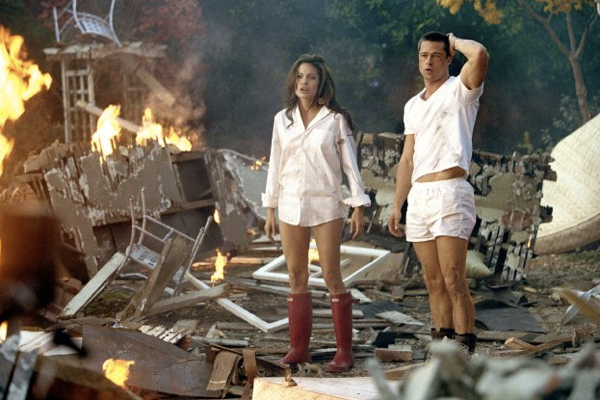Movie review by Greg Carlson
Several reviews of “Mr. and Mrs. Smith” relate the film to Ernst Lubitsch’s masterpiece “Trouble in Paradise,” and the comparison – while decidedly unfavorable toward the newer movie – is more than apt. Fans of the 1932 classic will certainly wonder if writer Simon Kinberg studied the brilliant scene in which two expert thieves seduce one another during a showcase of mutually spectacular pick-pocket skills; a similar sequence shows up in “Mr. and Mrs. Smith,” minus the deft, light-fingered touch that was Lubitsch’s signature. Of course, the characters Mr. and Mrs. Smith are world-class assassins, which provides the filmmakers with an opportunity to crank up the action at the expense of witty, sophisticated dialogue. Had the movie borrowed more from “Trouble in Paradise,” it might have been on to something.
Director Doug Liman, whose clever handling of energetic material in “Go” and “The Bourne Identity” proved that he could skillfully integrate brains and bullets, coasts by this time on the effortless charisma generated by topliners Brad Pitt and Angelina Jolie. The marquee players have been catnip to the tabloids of late, which will undoubtedly heat up the box office receipts – at least initially. It’s too bad the movie is not as scorching as its leading duo. As it is, viewers have to settle for a toned-down PG-13 rumpus that emphasizes cartoonish violence, when the movie would have been significantly better had it focused on the trickier sexual politics attending the wild central conceit.
Well-documented as the subject of Kinberg’s master’s thesis at Columbia, the premise of “Mr. and Mrs. Smith” would have us believe that this impossibly good looking couple, married for at least a half decade, have been able to keep their parallel livelihoods as contract killers secret from one another. The preposterousness of the situation hints at a rich subtext exploring the strains of routine and the perils of blocked intimacy, but “Mr. and Mrs. Smith” largely ignores its opportunities to say something about marriage. It turns out to be much easier to muzzle the talk and break out the machine guns instead.
There is no question Pitt and Jolie have appeal to spare, and one certainly expects that they will dominate the show, but “Mr. and Mrs. Smith” fails to develop any other important characters (sidekicks Kerry Washington and Vince Vaughn, doing his cute “Swingers” riff for the umpteenth time, barely register), which leaves the second half of the film desperately empty. Following a terrific knock-down melee in which the Smiths destroy their beautiful home en route to some tantalizing make-up sex, the movie settles for the commonplace sight of big-ticket car chases and shoot-outs.
With all this talent coming together, “Mr. and Mrs. Smith” should have resisted playing to the lowest common denominator. At the beginning and end of the movie, Pitt and Jolie are posed in a two-shot, directly facing the audience. As each partner responds to questions, Liman’s coy, therapy session set-up hints at a hipper, sexier movie than the one we get when the Smiths aren’t visiting with their counselor (nicely voiced off-screen by William Fichtner). These scenes are worth so much more than the third-act pyrotechnics that stand-in for what passes as plot. “Mr. and Mrs. Smith” is worth seeing, but one gets the feeling that underneath the hype, it’s just another big budget movie far too dependent on special effects and razzle-dazzle.
